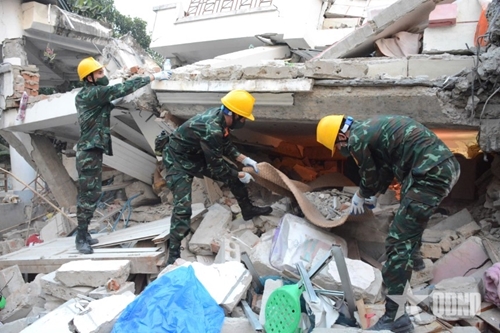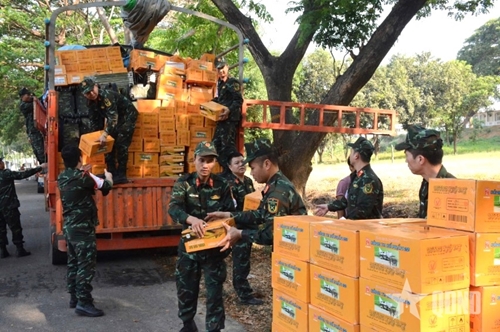Upon arriving at the airport, we were greeted by Yangon Region Chief Minister U Soe Thein. In a brief conversation with Major General Pham Van Ty, head of the Vietnamese People's Army team, the Chief Minister expressed his heartfelt thanks to Vietnam for swiftly sending forces to help Myanmar recover from the earthquake. He highlighted that this gesture was a testament to the deep friendship between the two nations and peoples.
    |
 |
|
Urgently conducting the search and rescue operation for victims trapped under the rubble |
It seemed he had much more to say. However, realizing the team’s urgency to reach the scene to conduct the mission, he thanked us once more and swiftly bid us farewell. Three 45-seat buses, carrying over 100 military and public security rescuers, sped off into the night toward Naypyidaw. The approximately 500-kilometer route from Yangon to Naypyidaw was marked by pitch-black surroundings, with only the occasional flash of headlights from oncoming cars briefly illuminating the darkness before fading away. This scene made members of the Vietnamese team, who had just arrived in Myanmar, reflect on the immense suffering and destruction the country was enduring after the earthquake: pain, loss, and many regions still shrouded in darkness.
After more than three hours traveling, the entire team made a stop at a rest station along the route. The team leader announced a brief ten-minute break for dinner and personal hygiene. The stop resembled those in Vietnam, with small stalls offering various goods, though snacks were the most common items. Vietnamese Defense Attaché Senior Colonel Dao Van Duy, who studied in Myanmar for three years and is now working in the country, suggested we try some local dishes but cautioned that newcomers might find it challenging to adapt to the local cuisine. Fortunately, this wasn’t a big concern. On the flight from Hanoi to Yangon, knowing the rescue team would have a tight schedule, Vietjet had prepared a box of food for each member of the team to take along on the journey.
    |
 |
|
Service dogs deployed to detect possible victims |
As the team was getting ready to leave, a young man, likely a local, approached and began speaking with the military reporters. He talked for a while, but upon realizing we didn’t understand Burmese, he repeatedly said, "Mandalay, Mandalay..." The reporters exchanged glances and nodded. Mandalay is the city at the epicenter and also the hardest hit by the earthquake on March 28. It seemed the young man mentioned Mandalay because he knew that our team had come to assist his country in recovering from the disaster.
Upon arriving in Naypyidaw, the scale of the earthquake's destruction was immediately apparent, particularly when we saw the cracks in the wide roads in the city center and as we entered the Bala Tidi area in Zabu Thiri district. The area was home to many 3-4 story villa-style buildings, but most had collapsed, either partially or completely, due to the 7.7 magnitude earthquake that had struck just days before. In front of each house, people had stacked the belongings they managed to salvage from the wreckage. Makeshift shelters were set up every few meters along the roadside, providing some form of temporary refuge.
    |
 |
|
The rescue team of the Vietnam People’s Army hands over dry provisions to earthquake victims. |
In Bala Tidi, I met an elderly woman sitting motionless on a chair covered in dust, and her eyes blankly fixed on her completely destroyed home. When I approached her, she shared that her 33-year-old daughter had gone missing since the earthquake. It was only when the rescue team arrived that a flicker of hope seemed to appear in her eyes. A coordinator for the Myanmar rescue operations informed us that many others in Bala Tidi were in a similar situation, anxiously waiting for news of their loved ones. This was the reason why the Vietnamese team chose this area as the starting point for the search operation.
After a long journey, the Vietnamese team finally arrived in Naypyidaw, but our mission to assist the people in the earthquake-stricken area was just beginning...
By Vu Hung (from Naypyidaw, Myanmar)
Translated by Tran Hoai